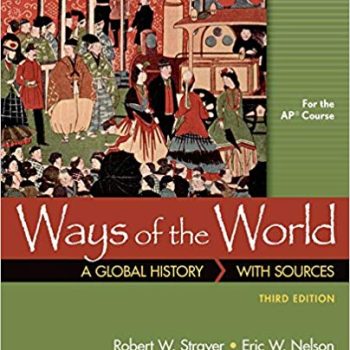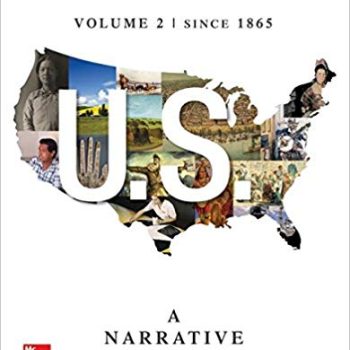Test Bank For A History of World Societies Combined Volume 10th Edition By John P. McKay
Answer each of the following questions with an essay. Be sure to include specific examples that support your thesis and conclusions.
|
1. |
What are some of the problems in using evidence from contemporary gatherer societies to study early humans? |
|
2. |
How did early Homo erectus spread out of East Africa into other parts of the world? Where did they go, and how early did they reach those places? |
|
3. |
What were the key features of Paleolithic food attainment and Paleolithic diets? |
|
4. |
What are some of the theories about gender relationships in Paleolithic societies? What changed in those relationships in the Neolithic period? What kinds of evidence are used in supporting or arguing against these theories? |
|
5. |
What is the relationship between pastoralism, disease, and humans? |
|
6. |
How did material goods create, define, and perpetuate social hierarchies in Neolithic societies? |
Answer Key
|
1. |
Answer would ideally include:
• Because the earliest humans did not leave behind written evidence, scientists have studied more recent societies that lived by similar gathering means. However, most evidence about recent gatherer societies was written by external sources and thus includes their biases and expectations, such as the inferiority of foraging as a lifestyle. Furthermore, few modern foragers or gatherers are truly isolated from the influence of other agricultural or industrial cultures. Also, this approach assumes that gatherer societies are somehow static and remain unchanged over many centuries, which ignores the evidence of how adaptable such societies really are. |
|
2. |
Answer would ideally include:
• Homo erectus migrated out of East Africa into central Africa, and then into northern Africa. This migration took place 2 million years ago. As early as 1.8 million years ago, Homo erectus had spread to Asia, reaching China and Java by 1.5 million years ago. These migrations took place over land, along coastline routes. Because sea levels were lower then, individuals could cross from the mainland of China to Java on foot. Homo erectus also moved northward from Africa, into Spain by 800,000 years ago and into Germany 500,000 years ago. In each of these places, they adapted hunting and gathering techniques to the local environment. |
|
3. |
Answer would ideally include:
• The Paleolithic diet consisted of a combination of plants and animal protein. Paleolithic peoples foraged for their food, engaging in what we would consider a combination of hunting, scavenging, and gathering. Most of what they ate were plants. Animal protein often came from scavenged foods like insects and shellfish rather than being hunted directly. It is unknown as to whether labor was divided between genders, but in today’s foraging societies, there is some division, with men engaging in hunting large animals and women responsible for gathering plants and small animals. It took between ten and twenty hours per week to gather food, but this number varied depending on environmental factors and group decisions. Because Paleolithic peoples had to forage for their diet, they expended energy and, in general, avoided diseases common in sedentary societies. Life spans were kept in check by accidents, injuries, and infections. |
|
4. |
Answer would ideally include:
• Studies of more recent foraging societies suggest that women were valued for their labor, which was recognized as equal to the work of men. Both men and women foraged for food, and both participated in hunting. Other scholars theorize that even in Paleolithic society one person may have emerged as a leader, perhaps based on personal skill, and that this person was almost always a man. It is more certain that by the Neolithic period, after the invention of plow agriculture, society became more hierarchical and men took on more of a public, elite status. Women were limited to the home or enclosed spaces, and land inheritance favored men over women. Evidence for gender roles in the Neolithic period comes from later written traditions. |
|
5. |
Answer would ideally include:
• Pastoralism is the herding and raising of livestock. It requires humans to live in close contact with their herd animals, thus exposing humans to various animal-borne diseases, such as smallpox. Initially, exposure to diseases may have caused higher mortality rates in pastoralist societies, but over time, humans would have developed some resistance to them. Foragers were not exposed to these diseases and thus did not develop any resistance to them. When a pastoralist society encountered a forager society, this might have led the former to expose the latter to deadly pathogens. |
|
6. |
Answer would ideally include:
• The possession of material goods—such as livestock, dwelling structures, plows, carts, and pots—indicated that some individuals had control over more labor. Labor was used to acquire material goods. The more material goods one had, the more labor one controlled. This indicated status; to control labor was to have a higher status than others. Having material goods gave one the ability to acquire yet more material goods and to continue to acquire status. Material goods, along with land, could also constitute an inheritance, and thus perpetuate status into the next generation. |








Reviews
There are no reviews yet.